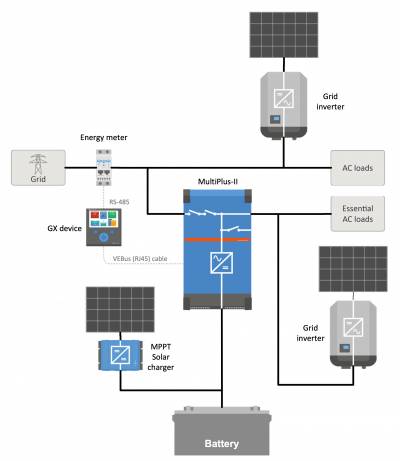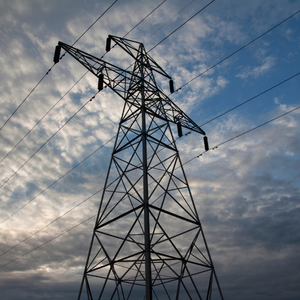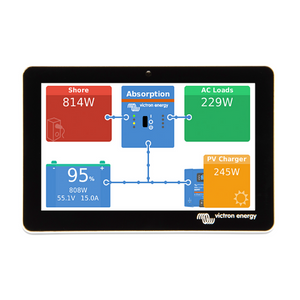| Home Energy SystemsHome energy systems or Energy Storage Systems (ESS) are growing in popularity and their ability to generate clean energy for our home use and reduce our energy bills is a significant reason why the UK alone saw a 70% growth in annual installed capacity in 2020. These systems have seen huge success in Australia where more than 30% of households now have rooftop PV Panels with a combined capacity of 11GW. In this article, we will run you through what a home energy system is and how it could benefit you. What Makes Up A Home Energy System/ESS? A home energy system or ESS is a system that integrates the local power grid with a battery system that can be used throughout the day. The systems are often comprised of a solar panel array, a solar controller, a solar inverter, batteries, an inverter/charger & an energy meter (for monitoring the amount of energy fed back to the grid).
Image from Victron Energy Why Have An ESS? These systems can be used for self-consumption, meaning you can use a percentage of the battery's energy for powering your home and keep the remaining percentage as a backup should you need it. Using such systems not only provide you with a safety net should the grid lose power thanks to the battery capacity, but also cut energy costs and can even earn you money by feeding power back into the grid under the Smart Export Guarantee (SEG) tariff offered by selected utility providers. Some people can also use these types of systems for "Time Shifting", which is the practice of storing solar energy for use during a time when you may be charged peak rates for electricity and only using grid energy when it is at its cheapest. ESS Systems are also great for areas where blackouts may be common, By having a battery system in place with an Inverter/Charger like our Victron MultiPlus range, you can keep the batteries topped up without the need for solar. Once the gird loses power the system will automatically switch over to battery power to supply your priority AC loads via the inverter. Feed-In Or No-Feed In? Feed-in refers to feeding energy harvested from renewable sources back into the grid. It is important to know with an ESS system if you want to have a feed-in system or a no-feed-in. Different countries around the world have different rules. In some countries, it can cause inflated bills because the electricity meter can only count in one direction - up. Every kWh fed back to the grid is erroneously counted as the energy used and will be charged for. In countries like South Africa, some prepaid meters will disconnect from the grid if a feed-in is detected.
Grid-Tied Solar Inverter Or MPPT Solar Controller? You might have seen both of the above items used in conjunction with solar panels in an ESS system, but why is this and what's the difference? If you currently have a PV installation that feeds energy straight to the grid it will utilise a grid-tied solar inverter which will change the DC current produced by the solar panels into AC current that can feed your household circuits and/or feed power back to the grid. This existing setup could easily be integrated with an inverter/charger and battery bank to create an ESS system by simply adding it to the AC load (see green box in the below image) or the AC input (see red box in the below image). Connecting it to your domestic loads would mean that all PV energy would be used to run your household circuits, so some may be wasted if not used as it would not be stored in your batteries. Connecting it to the AC input of the inverter/charger will allow you to charge the batteries, however, it is highly inefficient. This is due to the fact the grid inverter will transform the current from DC to AC and then the inverter/charger will convert from AC back to DC, resulting in up to a 30% power loss.
Image from Victron Energy edits by 12 Volt Planet 48 Volt systems Looking at our range of home energy components you may have noticed that most are designed for use with 48V battery systems. This is due to the high energy demands of household systems, and the requirement to keep cable sizes within reasonable levels. Voltage drop is a huge issue in low voltage applications so by using higher voltages we can use smaller cable sizes than we would be able to if we used 12V or 24V systems. Energy density also plays a huge role as you can see below
This means that with a 48V battery bank we can potentially store more energy meaning should the grid fail or you want to run just from the battery, we will have more capacity to do so. For AC-coupled systems, it is advised to have 4.8Kwh of battery per 1.5kWp (kiloWatt-peak) of solar with lithium batteries (5kWh per 1kWp for lead acid batteries). Monitors & Alarms Monitors are extremely helpful for ESS systems as not only can they provide you with a lot of information about the performance of the system, but you can change settings and parameters and configure alarms to activate under certain conditions. For example, some ESS systems may have emergency generators, and by using the monitor you can program an automatic start system so if the grid fails and your batteries are low the generator would start which would supplement your power requirements and recharge your batteries.
Others users may simply want an audible alarm to alert them to reduce their power usage and allow their PV panels to recharge the batteries. You can also monitor remotely from anywhere in the world using Victron's VRM (Victron Remote Management) portal. This portal allows you to make changes to your system when not even at the property and can provide remote access to technical teams to assist with problem-solving. We hope you have found this article helpful, however, if you do have any further questions please contact our sales team on 01844 885 100 or sales@12voltplanet.co.uk Disclaimer - The information contained in these articles is provided in good faith and we do our best to ensure that it is accurate and up to date, however, we cannot be held responsible for any damage or loss arising from the use or mis-use of this information or from any errors or omissions. The installer is ultimately responsible for the safety of the system so if you are in any doubt, please consult a qualified electrician. |
12 Volt PlanetAuto & Marine Electrical Components |




.png)







